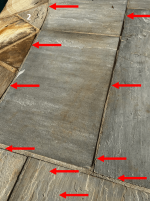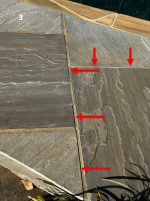- Jun 11, 2021
- 86
- Pool Size
- 18500
- Surface
- Plaster
- Chlorine
- Salt Water Generator
- SWG Type
- Pentair Intellichlor IC-40
Hi everyone,
Our IG saltwater pool was completed just about 2 years ago and everything has been mostly good - we love it!
I started noticing cracks forming both between the coping stones and the patio stones, as well as in the grout between the patio stones during the summer, so less than two years after the pool had been completed. I even noticed a patio stone gained a crack too. I reached out to the pool builder and asked him to come and check it out. It took him a few months to get around to it and, of course, he showed up without notice on a day I was away. He said the cracking is to be expected and not out of the ordinary.
I decided to map the extent of the cracking and one of the attached pictures indicates all of the cracks which measure between hairline and maybe a sixteenth or two of an inch wide.
I sent the map over to the PB who responded:
"When (the stone mason) and I came to your house a few weeks back we noticed some normal expansion of the areas in question. All masonry expands and contracts at different rates. Especially in our climate especially since last year at this time it was 6 degrees for two days and then 100 degrees this past summer for a few days. Concrete decking will heave and the pool will not move as is normal tolerances.
The cracks we noticed are not abnormal however if you’d like them fixed we can. The grout will not match and it will happen again over time. It’s just the nature of concrete and masonry. There is no warranty for concrete decking for cracks and masonry that’s on top will also mimic it’s base. It’s not a warrantable repair but we’d be happy to work with you on a solution."
So the worst case scenario is it seems we'd split the cost.
I looked up any construction regulations for pools in Georgia and found a section referencing the join between the patio and the coping but it doesn't mention a flexible grout under "m" here:
I read all the time on this forum that flexible grout should be used between the coping and the patio and am surprised it's not an SOP for all pool builds. Traditional grout was used on our pool unfortunately.
I wanted to ask the community, and especially pool owners around Atlanta, GA a few questions:
-Was your pool completed with a flexible grout between the coping and the patio stones?
-Have you needed to provide it with any maintenance (replace the flexible grout etc.)?
-Have you had any cracking in the grout between your patio stones?
-How has your PB responded if you've brought the issue up with them?
-Is there an expectation for pool owners to build regrouting costs every two years into the cost of pool ownership?
The cracks will only get bigger so must be addressed, and I'm quite comfortable doing any portion deemed to be my responsibility myself, but I read grout can be expected to last up to 10 years so am surprised so much of it is cracked already.
Some guidance for the pictures:
-I've placed a white box on the full pool pic to indicate where the crack pictures were taken
-The black line across the bottom of the picture is a hose
-The crack indications around the perimeter of the spa indicate cracks at the base of the spa where it joins the patio
-I have a wooden sauna cabin on the right hand side - that sits directly on a raised section of the concrete bed. There's a crack visible in that concrete bed too
-The patio stones are 'grey flagstone' on a concrete base, just for info
I know the local environment means that all concrete eventually cracks so anything sitting on top of it will move too. I just want to know if I'm being unreasonable or being misled over an issue caused by poor material application, especially for the coping/patio joint.
Thank you in advance for your feedback and Merry Christmas, Happy Holidays!
Daniel.
Our IG saltwater pool was completed just about 2 years ago and everything has been mostly good - we love it!
I started noticing cracks forming both between the coping stones and the patio stones, as well as in the grout between the patio stones during the summer, so less than two years after the pool had been completed. I even noticed a patio stone gained a crack too. I reached out to the pool builder and asked him to come and check it out. It took him a few months to get around to it and, of course, he showed up without notice on a day I was away. He said the cracking is to be expected and not out of the ordinary.
I decided to map the extent of the cracking and one of the attached pictures indicates all of the cracks which measure between hairline and maybe a sixteenth or two of an inch wide.
I sent the map over to the PB who responded:
"When (the stone mason) and I came to your house a few weeks back we noticed some normal expansion of the areas in question. All masonry expands and contracts at different rates. Especially in our climate especially since last year at this time it was 6 degrees for two days and then 100 degrees this past summer for a few days. Concrete decking will heave and the pool will not move as is normal tolerances.
The cracks we noticed are not abnormal however if you’d like them fixed we can. The grout will not match and it will happen again over time. It’s just the nature of concrete and masonry. There is no warranty for concrete decking for cracks and masonry that’s on top will also mimic it’s base. It’s not a warrantable repair but we’d be happy to work with you on a solution."
So the worst case scenario is it seems we'd split the cost.
I looked up any construction regulations for pools in Georgia and found a section referencing the join between the patio and the coping but it doesn't mention a flexible grout under "m" here:
The areas where the decks join the pool and spa coping shall be designed and installed so as to protect the coping and its mortar bed from damage as a result of anticipated movement of adjoining decks. |
I read all the time on this forum that flexible grout should be used between the coping and the patio and am surprised it's not an SOP for all pool builds. Traditional grout was used on our pool unfortunately.
I wanted to ask the community, and especially pool owners around Atlanta, GA a few questions:
-Was your pool completed with a flexible grout between the coping and the patio stones?
-Have you needed to provide it with any maintenance (replace the flexible grout etc.)?
-Have you had any cracking in the grout between your patio stones?
-How has your PB responded if you've brought the issue up with them?
-Is there an expectation for pool owners to build regrouting costs every two years into the cost of pool ownership?
The cracks will only get bigger so must be addressed, and I'm quite comfortable doing any portion deemed to be my responsibility myself, but I read grout can be expected to last up to 10 years so am surprised so much of it is cracked already.
Some guidance for the pictures:
-I've placed a white box on the full pool pic to indicate where the crack pictures were taken
-The black line across the bottom of the picture is a hose
-The crack indications around the perimeter of the spa indicate cracks at the base of the spa where it joins the patio
-I have a wooden sauna cabin on the right hand side - that sits directly on a raised section of the concrete bed. There's a crack visible in that concrete bed too
-The patio stones are 'grey flagstone' on a concrete base, just for info
I know the local environment means that all concrete eventually cracks so anything sitting on top of it will move too. I just want to know if I'm being unreasonable or being misled over an issue caused by poor material application, especially for the coping/patio joint.
Thank you in advance for your feedback and Merry Christmas, Happy Holidays!
Daniel.






